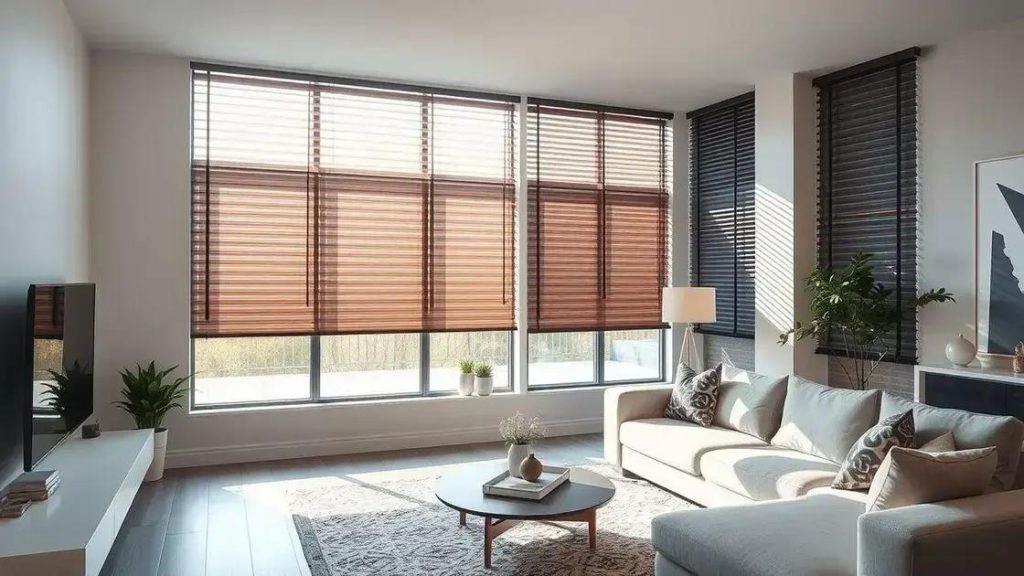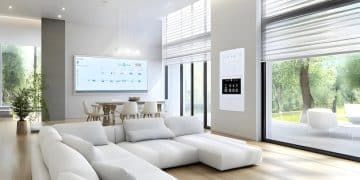Automating window blinds for efficiency: a smart choice

Automating window blinds enhances comfort, improves energy efficiency, and offers convenient control options, making it an excellent choice for modern homes.
Automating window blinds for efficiency is becoming a popular choice for modern homes. Imagine controlling the sunlight with just a tap on your smartphone. Are you ready to explore this convenient upgrade?
Benefits of automated window blinds
The benefits of automated window blinds are remarkable. Not only do they offer convenience, but they also enhance energy efficiency and security in your home. Imagine waking up and having your blinds automatically open to let in the morning light, all at the touch of a button.
Convenience and Comfort
One of the biggest advantages is the ease of managing your blinds. Instead of struggling with cords or manual adjustments, you can control your blinds with a smartphone or voice commands. This means you can set schedules for them to open or close based on your preferences.
Energy Efficiency
Automated blinds help to regulate indoor temperatures. By utilizing natural light during the day, you can reduce the need for artificial lighting. On hot days, having your blinds close automatically when the sun is at its peak can significantly lower air conditioning costs.
- Reduced electricity bills
- Better temperature control
- Less wear on HVAC systems
Enhanced Security
An often-overlooked benefit is the added security. Automated window blinds can create the illusion of someone being home, deterring potential intruders. You can set your blinds to open and close at different times while you’re away, making your home appear occupied.
Automated blinds also provide privacy at the touch of a button. Whether you want to enjoy a scenic view or block the outside world during a movie night, these blinds allow you to adjust your environment effortlessly.
In summary, the benefits of automated window blinds extend beyond aesthetics. With convenience, energy savings, and security features, they are a smart investment for any homeowner.
Types of automation systems

When exploring the types of automation systems for window blinds, it’s essential to consider various options available on the market. Automated window blinds can be categorized based on their control methods, ease of use, and features.
Motorized Blinds
Motorized blinds are among the most common types. They use an electric motor to raise, lower, or tilt the blinds. This type is incredibly convenient, as you can easily operate them with a remote control or smartphone app. They are perfect for hard-to-reach windows or for those who prefer a hands-free experience.
Smart Blinds
Smart blinds bring a new level of automation. These systems connect to your home Wi-Fi, allowing you to control them remotely through your smartphone or smart home device. You can set schedules, monitor statuses, and even integrate them with voice assistants like Alexa or Google Assistant.
- Remote access via smartphone
- Integration with home automation systems
- Customizable light control settings
Solar-Powered Blinds
Another innovative option is solar-powered blinds. These use solar panels to generate energy and power the motor. They are eco-friendly and help reduce energy consumption in your home. You won’t have to worry about batteries or electrical outlets with these blinds.
Understanding the different types of automation systems for window blinds can help you make the right choice based on your needs and lifestyle. Each system offers unique benefits, enhancing convenience and comfort in your living space.
How to choose the right system
Choosing the right automated window blind system can be simple if you consider a few essential factors. Start by evaluating your needs and preferences, as this will guide you toward the best option for your space.
Assess Your Needs
Think about the areas in your home where you want to install automated blinds. Are your windows hard to reach? Do you need them for privacy or energy efficiency? By identifying the specific needs, you can narrow down your choices.
Consider Control Options
Different systems offer various control methods. Some may use a remote control, while others can be operated via a smartphone app or voice assistant. Decide which control method suits your lifestyle best. For example, a family with young children may prefer a system that’s easy to manage and safe.
- Remote control for convenience
- Smartphone apps for flexibility
- Voice control for hands-free operation
Evaluate Aesthetics and Design
The design of the blinds themselves is also crucial. Automated blinds should complement your home’s decor. Look for colors and styles that fit seamlessly with your interior design. Choose materials that not only look good but are also durable and easy to maintain.
Pricing is another factor to keep in mind. Automated blinds come at a range of prices. Set a budget ahead of time. This allows you to find a system that meets your requirements without overspending.
Finally, check reviews and ratings; they can provide valuable insights into the reliability and performance of different systems. Reading testimonials from other users will help you make an informed decision.
Installation tips for automated blinds

Installing automated blinds can greatly improve your home’s comfort and efficiency. While it may seem challenging, following some easy tips can make the process smoother.
Gather Your Tools
Before starting, make sure you have all necessary tools on hand. This typically includes a drill, screwdriver, tape measure, and level. Having everything ready will save you time and frustration.
Read the Instructions
Always begin by reading the manufacturer’s instructions. Each system may have specific guidelines for installation. Familiarize yourself with the components to ensure a proper setup.
- Check the parts list for completeness
- Understand the installation steps before starting
- Look for any safety warnings
Choose the Right Location
Decide where to install the blinds. Make sure that the location allows for optimal light control and privacy. It’s best to place them where they can easily be adjusted. Consider windows that catch direct sunlight, as this will enhance energy savings.
Make sure to mark the spots for brackets accurately. Use a level to ensure your blinds hang straight. This will not only look better but also function more effectively.
Once you have installed the brackets, attach the blinds according to the instructions. Double-check that everything is secure before moving to the next step. After installation, test the system to ensure it operates smoothly.
In conclusion, automating window blinds offers numerous benefits that enhance comfort, convenience, and energy efficiency in your home. Choosing the right system requires careful consideration of your needs, control options, and design preferences. Installing these blinds can be straightforward, especially with the tips provided. By making these thoughtful choices, you can transform your living space into a more enjoyable and efficient environment.
FAQ – Frequently asked questions about automating window blinds
What are the main benefits of automating window blinds?
Automating window blinds provides enhanced comfort, energy efficiency, and added security in your home.
How do I choose the right automated blind system for my home?
Consider your specific needs, control options, and design preferences to find the best system for your space.
Is the installation of automated blinds complicated?
No, with the right tools and instructions, the installation process can be quite straightforward.
Can automated blinds help save on energy costs?
Yes, they help regulate indoor temperatures, which can lead to lower energy bills by reducing the need for heating and cooling.





